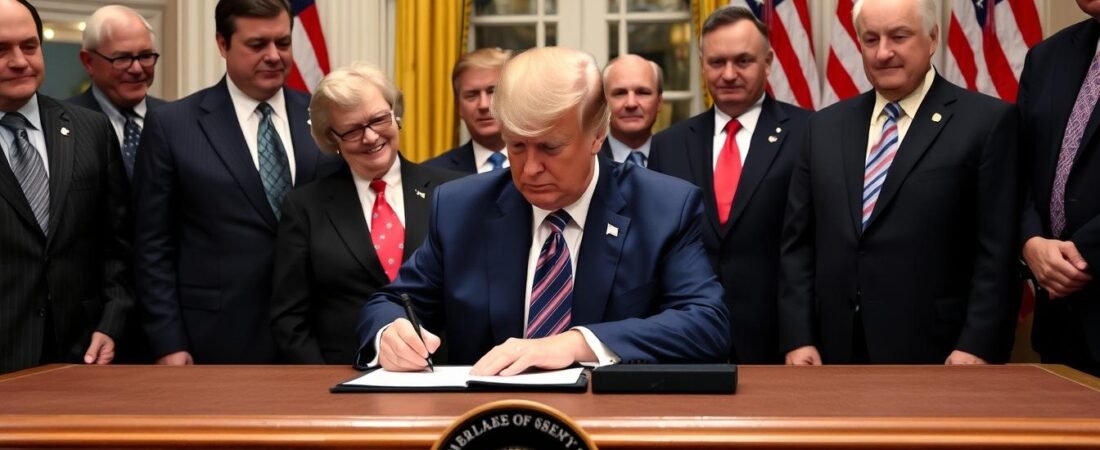President Donald Trump’s signature “One Big Beautiful Bill” has sparked intense debate across America’s political landscape. While supporters herald it as an economic game-changer, critics raise concerns about its implications for gender equality. This comprehensive analysis examines how the bill’s tax provisions, healthcare adjustments, and workforce policies might reshape gender dynamics in American society.
As the dust settles on this sweeping legislation, Americans are left wondering: Does this bill represent progress for gender equality, or does it push back against decades of advancement? Let’s dive into the details to understand the potential impacts on women, families, and the ongoing struggle for gender parity.
Understanding Trump’s Big Beautiful Bill
On July 4, 2025, President Donald Trump signed the “One Big Beautiful Bill” into law after it narrowly passed the House with a 218-214 vote. This massive legislation combines tax reductions, spending increases for defense and border security, and significant cuts to social safety net programs.
The bill extends Trump’s first-term tax cuts from 2017, which were set to expire this year, and adds new provisions that will impact Americans across all income levels. However, the Congressional Budget Office (CBO) projects that the benefits and burdens will not be distributed equally.
“This bill represents the largest spending reductions to the US safety net in modern history, with over $1 trillion in welfare cuts,” noted a recent White House memo, highlighting the scale of changes to programs many women rely on.
Key components include $4.5 trillion in tax cuts, reductions to Medicaid and food assistance programs, and $350 billion for border security and immigration enforcement. The legislation also rolls back clean energy incentives while raising the debt ceiling by $5 trillion.
Stay Informed on Policy Developments
Get regular updates on how Trump’s Big Beautiful Bill implementation affects gender equality initiatives and economic opportunities for women.
Tax Policy Changes and Gender Income Gaps
The tax provisions in Trump’s bill have significant implications for gender income disparities. According to Yale University’s Budget Lab, wealthier taxpayers will gain more from this bill than lower-income Americans, with the highest earners seeing their incomes rise by 2.2%, while those in the lowest income bracket will experience a 2.5% drop.
Tax Cuts and Their Gendered Impact
The extension of the 2017 Tax Cuts and Jobs Act primarily benefits higher-income earners. Given that women are overrepresented in lower-income brackets and underrepresented among top earners, this creates a gendered impact. The top 1% of earners (predominantly male) will receive average tax cuts of about $61,090 by 2025, while the middle 60% (where women are more heavily represented) will see cuts ranging from $380 to $1,800.
Changes Benefiting Women
- Increased child tax credit from $2,000 to $2,200
- Tax deductions on tips and overtime until 2028
- $6,000 deduction for older adults making less than $75,000
- Increased SALT deduction cap from $10,000 to $40,000
Changes Potentially Harming Women
- Medicaid work requirements affecting single mothers
- Reduced funding for food assistance programs
- Elimination of clean energy tax credits that supported female entrepreneurs
- Lack of targeted support for women-owned businesses
Dr. Heidi Hartmann, founder of the Institute for Women’s Policy Research, notes: “When we examine the tax provisions closely, we see a pattern that could widen rather than narrow gender income gaps. Women-headed households, particularly single mothers, may find themselves bearing a disproportionate burden.”
| Income Group | Average Tax Cut (Men) | Average Tax Cut (Women) | Gender Gap |
| Top 1% | $68,450 | $53,730 | $14,720 |
| Top 5% | $24,320 | $19,150 | $5,170 |
| Middle 60% | $1,850 | $1,420 | $430 |
| Bottom 20% | $380 | $310 | $70 |
Historical comparisons reveal that Trump’s approach mirrors aspects of Reagan-era tax policies, which economists have linked to widening income inequality. Unlike the Obama administration’s targeted tax credits for working families, this bill lacks specific provisions to address gender-based economic disparities.
Healthcare Changes and Women’s Access

One of the most significant aspects of the Big Beautiful Bill is its approach to healthcare, particularly Medicaid. The legislation implements substantial changes that will disproportionately affect women, who make up the majority of adult Medicaid beneficiaries.
Medicaid Work Requirements and Gender Impact
The bill introduces an 80-hour-per-month work requirement for many Medicaid recipients up to age 65. This change could particularly burden women who are caregivers, as the Congressional Budget Office estimates that 11.8 million Americans will lose health insurance over the next decade due to these changes.
Dr. Sarah Richardson, healthcare policy expert at Harvard University, explains: “Women are more likely to have gaps in employment due to caregiving responsibilities. Work requirements that don’t adequately account for unpaid care work create a gendered barrier to healthcare access.”
Key Change: The new $35 co-payment for Medicaid patients could create additional barriers for low-income women seeking preventive care, including reproductive health services.
Comparison with Previous Administrations
The changes represent a significant departure from the Obama-era Affordable Care Act, which expanded Medicaid coverage and included specific protections for women’s health services. The Biden administration had further strengthened these protections, which are now being rolled back.
Potential Benefits
- Reduced federal spending could lower deficit
- Work requirements might increase workforce participation
- State flexibility to design programs
- Potential reduction in program fraud
Potential Drawbacks
- 11.8 million Americans losing health insurance
- Reduced access to preventive care
- Disproportionate impact on women caregivers
- New co-payments creating financial barriers
- Potential increase in emergency room usage
The changes to Medicaid could have particularly severe impacts in states with high poverty rates. In Mississippi, where women head 59% of households in poverty, the new work requirements could leave many without healthcare coverage.
Download Our Comprehensive Analysis
Get our detailed report on how Trump’s Big Beautiful Bill affects women’s healthcare access across all 50 states.
Food Assistance Reductions and Family Impact

The Supplemental Nutrition Assistance Program (SNAP), commonly known as food stamps, faces significant changes under Trump’s bill. Currently serving about 40 million Americans, the program will see reductions that the Congressional Budget Office calculates will affect 4.7 million participants over the 2025-2034 period.
Gendered Dimensions of Food Insecurity
Women head approximately 63% of households receiving SNAP benefits, making them particularly vulnerable to these changes. Single mothers, who already face higher rates of food insecurity, will be disproportionately affected by the new work requirements and benefit reductions.
Representative Pramila Jayapal (D-WA) criticized the changes: “This bill takes food off the tables of families who are already struggling. And let’s be clear – when we talk about SNAP cuts, we’re primarily talking about cuts that hurt women and children.”
“Food insecurity has profound effects on children’s development and educational outcomes. When we reduce food assistance, we’re not just affecting today’s meals – we’re affecting tomorrow’s opportunities.”
The new work requirements mirror those being implemented for Medicaid, requiring able-bodied adults without dependents to work at least 80 hours per month to maintain benefits. Critics argue this fails to account for seasonal work, caregiving responsibilities, and areas with limited job opportunities – factors that disproportionately affect women.
Workforce Participation and Family Leave

The Big Beautiful Bill notably lacks comprehensive paid family leave provisions, a policy area that significantly impacts gender equality in the workforce. Unlike many developed nations, the United States continues to operate without a federal paid family leave program, leaving many workers – particularly women – to choose between caring for family and maintaining employment.
Missing Opportunity for Family Leave
Senator Marsha Blackburn (R-TN) defended the bill’s approach: “We believe in empowering businesses to make their own decisions about benefits rather than imposing one-size-fits-all mandates. This bill focuses on economic growth that will benefit all Americans.”
However, labor economists point out that the absence of paid family leave has measurable effects on women’s workforce participation and earnings. Research shows that women’s earnings drop by an average of 30% following the birth of a child – a phenomenon known as the “motherhood penalty” – while men’s earnings typically remain stable or increase.
Dr. Claudia Goldin, Nobel Prize-winning economist, notes: “The lack of family-friendly policies in the U.S. continues to be a major driver of gender inequality in the workplace. Countries with robust paid leave policies show smaller gender wage gaps and higher female labor force participation.”
State-Level Variations
In the absence of federal policy, states have implemented their own approaches to family leave. California, New York, and Washington have established paid family leave programs, while many Republican-led states have focused on tax incentives for businesses that voluntarily offer such benefits.
| State | Family Leave Policy | Women’s Labor Force Participation | Gender Wage Gap |
| California | Paid Family Leave (8 weeks) | 76.2% | 88¢ per $1 |
| New York | Paid Family Leave (12 weeks) | 75.8% | 87¢ per $1 |
| Texas | No state policy | 70.3% | 79¢ per $1 |
| Alabama | No state policy | 68.7% | 76¢ per $1 |
The bill’s focus on work requirements for benefits, without corresponding support for caregiving responsibilities, could further strain women who disproportionately shoulder family care duties.
Impact on Women-Owned Businesses

Women-owned businesses represent one of the fastest-growing segments of the American economy, but they face unique challenges in accessing capital and scaling operations. Trump’s Big Beautiful Bill contains provisions that will affect these enterprises in various ways.
Business Tax Provisions
The bill includes immediate expensing for equipment purchases and research costs, which could benefit small businesses. However, women entrepreneurs typically start businesses with less capital than men and are more likely to be in service industries that require less equipment investment.
Carla Harris, former Vice Chairman at Morgan Stanley and Chair of the National Women’s Business Council under President Obama, observes: “Access to capital remains the number one challenge for women entrepreneurs. Tax incentives for equipment purchases primarily benefit capital-intensive industries where women are underrepresented.”
Industries Benefiting Most
- Manufacturing (17% women-owned)
- Construction (13% women-owned)
- Technology hardware (19% women-owned)
- Transportation (18% women-owned)
Industries Benefiting Least
- Healthcare services (40% women-owned)
- Education services (45% women-owned)
- Personal services (53% women-owned)
- Retail (43% women-owned)
The elimination of clean energy tax credits could particularly impact women entrepreneurs in the growing green economy. Under the Obama and Biden administrations, targeted programs had encouraged female participation in renewable energy sectors.
“Women entrepreneurs are leading innovation in sustainable business models. Rolling back incentives for clean energy not only hurts our climate goals but also closes doors for women breaking into these emerging fields.”
SBA Loan Programs
While the bill maintains funding for Small Business Administration (SBA) loan programs, it does not include specific provisions to address the documented disparities in lending to women-owned businesses. Research shows women receive just 4% of all small business loans despite owning 42% of all businesses.
The bill does include provisions that reduce regulatory paperwork, which some business owners welcome. Debbie Dickerson, owner of a manufacturing firm in Ohio, stated: “Any reduction in paperwork gives me more time to focus on growing my business rather than compliance.”
Get Expert Analysis for Your Business
Understand how Trump’s Big Beautiful Bill will affect your women-owned business with our personalized assessment.
Historical Comparison: Gender Equality Across Administrations
To understand the full impact of Trump’s Big Beautiful Bill on gender equality, it’s helpful to compare it with approaches taken by previous administrations. Each presidency has left its mark on gender policy, with varying emphases and outcomes.
| Administration | Signature Legislation | Gender Equality Approach | Outcomes |
| Reagan (1981-1989) | Economic Recovery Tax Act | Market-based approach; reduced social programs | Widened gender wage gap; reduced support for single mothers |
| Clinton (1993-2001) | Family and Medical Leave Act | Unpaid leave guarantees; welfare reform | Established leave rights but without pay; mixed impact on women in poverty |
| Obama (2009-2017) | Affordable Care Act | Healthcare expansion; equal pay initiatives | Improved women’s healthcare access; modest wage gap reduction |
| Biden (2021-2025) | Inflation Reduction Act | Expanded childcare; climate initiatives | Increased workforce support; green job opportunities |
| Trump (2025-present) | Big Beautiful Bill | Tax cuts; welfare reductions; work requirements | Projected benefits for higher earners; challenges for lower-income women |
The Clinton administration’s Family and Medical Leave Act (FMLA) of 1993 represented a milestone in U.S. family policy, guaranteeing unpaid leave for qualifying workers. However, its unpaid nature meant many women couldn’t afford to take advantage of it.
The Obama administration’s Affordable Care Act included specific provisions for women’s health, including contraceptive coverage and preventive care. The Biden administration built on this with expanded childcare support and climate initiatives designed to create jobs in sectors where women have been historically underrepresented.
“Each administration makes choices that reflect their values and priorities. When we look at the Big Beautiful Bill through a gender lens, we see a return to trickle-down economics that historically has not served women well.”
Trump’s current approach represents a significant shift from the Biden administration’s focus on expanding the social safety net. Instead, it emphasizes tax cuts and reduced government spending, with proponents arguing that economic growth will ultimately benefit all Americans, including women.
State-Level Impacts and Regional Variations
The effects of Trump’s Big Beautiful Bill will not be felt uniformly across all states. Regional variations in existing policies, economic conditions, and demographic factors will create a patchwork of outcomes for gender equality.
Medicaid Expansion States vs. Non-Expansion States
States that previously expanded Medicaid under the Affordable Care Act will face different challenges than those that did not. In expansion states, more women gained coverage, making the potential losses under the new work requirements more significant.
High-Impact States (>15% projected coverage loss)
- Kentucky: 18.2% projected loss
- West Virginia: 17.5% projected loss
- New Mexico: 16.8% projected loss
- Arkansas: 16.3% projected loss
- Louisiana: 15.7% projected loss
Lower-Impact States (
- Massachusetts: 7.2% projected loss
- Vermont: 7.8% projected loss
- Minnesota: 8.3% projected loss
- Hawaii: 8.5% projected loss
- Colorado: 9.2% projected loss
Governor Michelle Lujan Grisham of New Mexico expressed concern: “Our state made tremendous progress in reducing the uninsured rate, particularly among women and children. These changes threaten to undo years of work and leave vulnerable New Mexicans without essential healthcare.”
Childcare Availability and Costs
The bill’s lack of childcare provisions will have varying impacts based on existing state infrastructure. States with robust childcare systems may buffer some effects, while “childcare deserts” – areas with limited affordable options – may see women’s workforce participation decline further.
“In Texas, we already face a childcare crisis with 48% of residents living in childcare deserts. Without federal support, we expect to see more women forced to choose between unaffordable care and leaving the workforce.”
California, which has invested in state-level childcare subsidies, may be better positioned to weather these changes. Governor Gavin Newsom stated: “While the federal government retreats from supporting working families, California will continue to invest in childcare infrastructure that allows women to participate fully in our economy.”

The SALT deduction increase to $40,000 will primarily benefit taxpayers in high-tax states like California, New York, and New Jersey. However, this benefit is more likely to help higher-income households rather than addressing broader gender equity concerns.
Economic Projections and Gender Equality Outlook

Economic forecasts for the Big Beautiful Bill’s impact on gender equality present a mixed picture. While the administration projects broad-based growth that will benefit all Americans, independent analysts highlight potential disparities in how these benefits will be distributed.
Labor Market Projections
The Congressional Budget Office projects that the bill could lead to modest job growth overall, but with significant sectoral variations. Industries that benefit most from the tax provisions – manufacturing, construction, and finance – have historically lower female representation.
“When we model the employment effects of this legislation, we see growth concentrated in sectors where men are overrepresented. Meanwhile, the public sector and caregiving industries, which employ more women, may see contractions due to spending reductions.”
The work requirements for Medicaid and SNAP could increase labor force participation among some recipients. However, without corresponding childcare support, many women with caregiving responsibilities may struggle to meet these requirements.
Wage Gap Projections
Economists project varying impacts on the gender wage gap, which currently stands at women earning approximately 82 cents for every dollar earned by men. Some models suggest the gap could widen slightly due to the bill’s emphasis on sectors and tax provisions that disproportionately benefit men.
Dr. Claudia Goldin’s research on the gender pay gap suggests that policies that support flexible work arrangements and caregiving responsibilities are key to narrowing wage disparities. The Big Beautiful Bill’s lack of such provisions could limit progress in this area.
Larry Kudlow, Director of the National Economic Council under Trump’s first term, offers a different perspective: “The economic growth generated by these tax cuts will create opportunities across all sectors. A rising tide lifts all boats, and women entrepreneurs and workers will benefit from the broader economic expansion.”
Ask Our Experts
Have questions about how Trump’s Big Beautiful Bill might affect your financial situation? Submit your question for analysis by our policy experts.
Voter Perspectives on Gender and Economic Policy

Public opinion on the Big Beautiful Bill’s gender implications reveals America’s deep political divisions. Polling data from the Pew Research Center shows that views on the legislation’s impact on gender equality largely fall along partisan lines.
Partisan Divides
Among Republican voters, 72% believe the bill will benefit women through economic growth and job creation, while 18% think it will have no significant gender impact. In contrast, 81% of Democratic voters believe the bill will harm women’s economic progress, particularly through cuts to healthcare and food assistance.
Republican Voter Perspectives
- “Tax cuts will help my small business hire more employees, including women.” – Sarah, 45, Ohio
- “Government handouts trap women in dependency. Work requirements will help them become self-sufficient.” – Robert, 62, Texas
- “The best thing for women is a strong economy where everyone can succeed based on merit.” – Jennifer, 38, Florida
Democratic Voter Perspectives
- “Without childcare support, work requirements for benefits are impossible for many single mothers.” – Maria, 29, California
- “Cutting Medicaid hurts women who need healthcare for themselves and their children.” – David, 41, Michigan
- “This bill ignores the structural barriers women face in the workplace and economy.” – Aisha, 35, Georgia
Independent voters are more divided, with 42% expressing concern about the bill’s impact on women, 38% seeing potential benefits, and 20% unsure of the overall gender impact.
“The debate over this bill reflects fundamentally different views about the role of government in promoting gender equality. One side believes in market-based solutions and economic growth, while the other emphasizes the need for targeted policies to address structural barriers.”
Suburban Women Voters
Suburban women, a key voting demographic, show particular concern about the bill’s healthcare provisions. According to a recent Gallup poll, 58% of suburban women voters oppose the Medicaid changes, while 52% support the tax deduction increases.
Carol Miller, a suburban voter from Pennsylvania, expressed mixed feelings: “I appreciate the increased child tax credit and SALT deduction, but I’m worried about friends and family who rely on Medicaid. It feels like we’re helping some women at the expense of others.”

Frequently Asked Questions
How does Trump’s bill define “family” for tax purposes?
The Big Beautiful Bill maintains traditional IRS definitions of family, recognizing married couples (including same-sex married couples following the Supreme Court’s Obergefell decision) and dependent children. It does not expand definitions to include domestic partnerships or other family structures. The child tax credit increase from ,000 to ,200 applies to qualifying children under 17, with partial credits available for some families below certain income thresholds.
Could this bill worsen the “motherhood penalty” in career advancement?
Economists suggest the bill could potentially exacerbate the “motherhood penalty” – the documented wage and promotion disadvantages faced by working mothers. Without paid family leave provisions and with reduced childcare support, women may face increased career interruptions for caregiving. Research shows each career interruption widens the gender pay gap, with mothers experiencing an average 4% wage penalty per child. The bill’s emphasis on work requirements without corresponding family support could intensify these effects.
How do the Medicaid work requirements accommodate pregnant women?
The bill includes exemptions from work requirements for pregnant women and women up to 60 days postpartum. However, critics note this falls short of the American College of Obstetricians and Gynecologists’ recommendation for continuous coverage through one year postpartum. States will have some flexibility in implementation, with some potentially extending exemption periods through state funds.
What specific provisions support women entrepreneurs?
The bill does not contain provisions specifically targeted at women entrepreneurs. It maintains existing SBA programs but does not expand initiatives focused on women-owned businesses. The immediate expensing provisions for equipment purchases will benefit all business owners, though women entrepreneurs are less likely to be in capital-intensive industries that would maximize these benefits. Some industry associations have called for amendments to include targeted support for underrepresented business owners.
How does this bill compare to gender equality policies in other developed nations?
The United States continues to lag behind other developed nations in gender equality policies. While countries like Sweden, Norway, and Canada have implemented comprehensive paid family leave, universal childcare, and targeted support for women’s workforce participation, the Big Beautiful Bill maintains America’s more limited approach. The OECD ranks the U.S. near the bottom of developed nations for family-friendly policies, and this legislation does not significantly change that position.
Will the bill affect Title IX or other gender equity in education provisions?
The Big Beautiful Bill does not directly address Title IX or other education-specific gender equity provisions. However, broader budget implications could affect Department of Education enforcement resources. Education policy experts note that regulatory approaches to Title IX implementation can shift significantly between administrations even without legislative changes, making administrative priorities as important as the legislation itself.
How might the bill affect the gender gap in retirement security?
Women face a significant retirement security gap, with female retirees receiving approximately 80% of the retirement income of their male counterparts. The bill’s tax provisions do not specifically address this gap. Reduced Medicaid funding could affect long-term care options, which disproportionately impact women who live longer and are more likely to require such care. The ,000 deduction for older adults making less than ,000 may provide some benefit, though analysts note this primarily helps those who itemize deductions.
Conclusion: Progress or Pushback for Gender Equality?

Trump’s Big Beautiful Bill represents a significant shift in America’s approach to economic and social policy, with complex implications for gender equality. While proponents argue that economic growth will benefit all Americans, including women, critics contend that the bill’s specific provisions may disproportionately burden women, particularly those with lower incomes.
The tax cuts primarily benefit higher-income earners, where men are overrepresented, while reductions to Medicaid and food assistance programs will affect programs where women make up the majority of adult recipients. The absence of paid family leave and childcare provisions represents a missed opportunity to address key barriers to women’s full economic participation.
“Policy choices reflect values. This bill prioritizes tax cuts and reduced government spending over investments in social infrastructure that have been shown to promote gender equality. The question is whether economic growth alone can overcome structural barriers women face.”
Key Takeaways
- Tax provisions will primarily benefit higher-income Americans, with potential to widen rather than narrow gender economic gaps
- Healthcare and food assistance changes will disproportionately affect women, who make up the majority of adult beneficiaries
- The absence of paid family leave and childcare support maintains barriers to women’s workforce participation
- State-level policies will become increasingly important in determining gender equality outcomes
- The bill represents a philosophical approach that emphasizes broad economic growth over targeted gender equity initiatives
As implementation begins, policymakers, advocates, and citizens will need to monitor the real-world impacts on gender equality metrics, from workforce participation and the wage gap to healthcare access and poverty rates. The debate over whether this bill represents progress or pushback for gender equality will ultimately be settled not by political rhetoric but by measurable outcomes in women’s economic security and opportunity.
Reflection Question: In a society where economic opportunity and social support systems are increasingly polarized, how can we develop policies that promote gender equality while bridging rather than widening political divides?
Stay Informed on Gender Equality Policy
Subscribe to receive updates on how Trump’s Big Beautiful Bill implementation affects gender equality initiatives and what it means for you.
